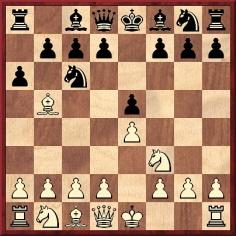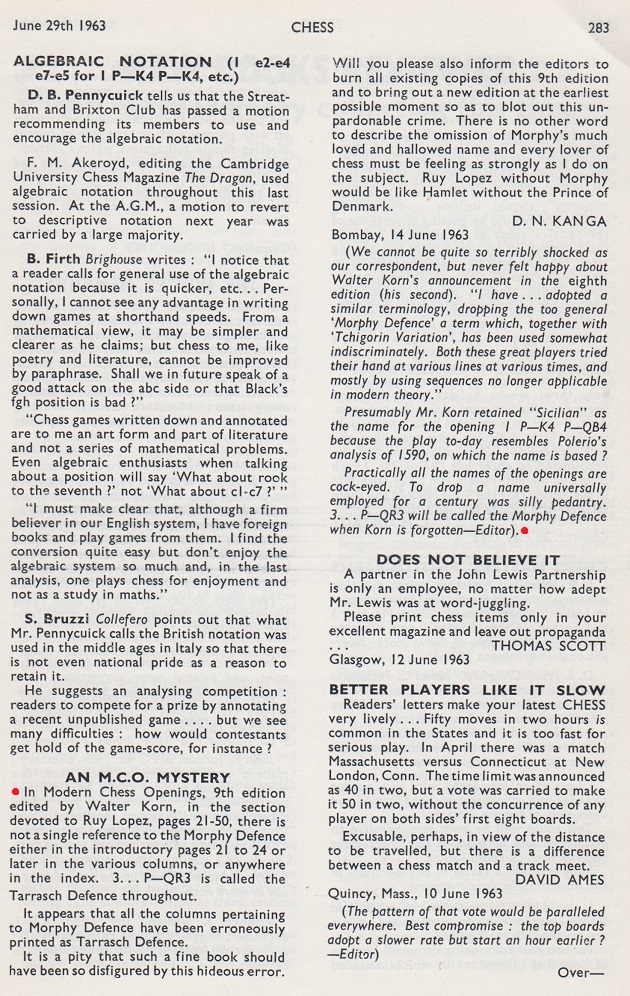
Edward Winter

Héctor B. Kuperman (Madrid) asks:
‘Who invented the name “Morphy Defence” in the Ruy López? According to the comprehensive collections of Morphy’s games, he played the defence only a few times.’
Can anyone offer an authoritative reply?
For pre-Morphy instances of 3...a6 see the ‘Morphy Defence’ entry in the Oxford Companion to Chess.
From Brian Donnell (Portland, OR, USA):
‘I think I can narrow the search to the turn of the century. Steinitz, in The Modern Chess Instructor (1889), writes: “... Morphy, who, as usual at the time, had played 3...P-QR3”, but games in the Oxford Encyclopedia do not show this defence to have been widely adopted. 3...Nf6 seems to have been the favourite both pre- and post-Morphy. In Bird’s Chess Novelties (1895), page 5, I find the ...a6 defence beside the name of Zukertort. In the fifth edition of Cook’s The Chess Players’ Compendium (1910) 3...a6 is called after Morphy, both in the main tables, which probably date to 1902, and in the supplement by Alfred Emery. Is it called “the Morphy Defence” in Cook’s Synopsis of the Chess Openings?
For the August 1984 issue of Chess Life, Andy Soltis and Gene McCormick supplied an article entitled “The Morphy Defense”, condensed from their then forthcoming book on the US championship (McFarland, 1986). In it, they argue that Morphy was inspired to adopt (and perfect) 3...a6 by two games in the Rousseau-Stanley match. I disagree.
I believe that the intellectual credit for the “Morphy” defence belongs, as the Companion hints, to Löwenthal, who “converted” Morphy in their final match game. Is it too late to re-name 3...a6 “the Löwenthal Defence”?
Our correspondent enclosed the following material:
a) Löwenthal’s account of his stay in the US and his search for a satisfactory defence to the Ruy López (page 393 of The Book of the First American Chess Congress).
b) Page 63 of Marache’s Manual of Chess (1866), which gives ‘Löwenthal’s Defence’: 1 e4 e5 2 Nf3 Nc6 3 Bb5 a6 4 Ba4 Nf6 (‘This defence to the formidable “Ruy López” takes rank among the most scientific discoveries elaborated by modern analysis. Feeling the intrinsic weakness of 4...b5, but recognizing the force of 3...a6, Herr L., after much thought and analysis, demonstrated that the moves, as given here, formed the true parade to White’s hitherto almost unanswered thrust.’) 5 d4 (‘5 d3 is a favorite of Prof. Anderssen at this point; and the German Handbuch gives 5 O-O and though White can get an even game, he can get nothing more.’) 5...exd4 6 e5 Ne4 7 O-O Nc5 8 Bxc6 dxc6 9 Nxd4 Ne6 10 Nxe6 Bxe6 11 Qe2 Bc5 12 Nc3 Qe7 ‘and White can only get an equal game’.
c) Pages 106-107 of Löwenthal’s book Morphy’s Games of Chess, which publishes a Morphy-Löwenthal game in which the above moves occurred. After 12...Qe7 Löwenthal comments: ‘The second player has now a game as good as can be expected in defending the Ruy López attack.’
d) Pages 328-330 of Lange’s The Chess Genius of Paul Morphy, the Hippocrene reprint of Lange’s Paul Morphy – Sketch from the Chess World. In this same Morphy-Löwenthal game Falkbeer, the translator, comments after 12...Qe7: ‘Black’s forces are now completely developed, a fact which, in our opinion, is highly creditable to the second player, considering the strong attack he has to contend against in the Ruy López. Surely the game deserved a better fate, if it were only for the great skill with which, up to this point, it was conducted by Herr Löwenthal, whose perfect knowledge of the openings surpasses nearly every other player of his own strength and experience.’
Mr Donnell also mentions that there are interesting notes to this game on pages 2-5 of König’s Chess from Morphy to Botwinnik.
Rob Verhoeven (The Hague, the Netherlands) provides photostats of the four editions of Cook’s Synopsis of the Chess Openings. The first (1874, page 12) calls 3...a6 ‘the best defence’ but mentions Morphy only in a footnote giving the opening moves of the Morphy-Löwenthal game. The second edition (1876, page 18) repeats the ‘best defence’ remark but omits any reference to the Morphy-Löwenthal game. The third edition (1882, page 24) comments: ‘Herren Zukertort, Rosenthal, and other first-rates, have rejected Morphy’s favourite defence 3 P-QR3, probably on account of the dullness of the positions which arise therefrom, but Steinitz says, in The Field, that he does not think any palpable inferiority can be demonstrated for the second player if he adopts 3 P-QR3, which is another way of saying that it is useful in certain variations to have played 3 P-QR3, and that in others it does not in any way compromise or materially alter the position.’ Page 25 has the following note on 3...a6: ‘This defence was, until lately, adopted in all important contests, but it is now considered unnecessary to play it immediately, as in certain variations it is a loss of time.’ The fourth edition of Cook’s book (1888, page 24) states: ‘Morphy’s defence P-QR3 still holds good – but in modern practice there appears to be a tendency to defer playing it until learning the line of attack the first player proposes to adopt.’ However, the next page describes 3...a6 as ‘the safest defence’. It may be noted that Cook writes ‘Morphy’s defence’ and not ‘Morphy’s Defence’.

See too Paul Morphy.
To the Chess Notes main page.
To the Archives for other feature articles.
Copyright: Edward Winter. All rights reserved.